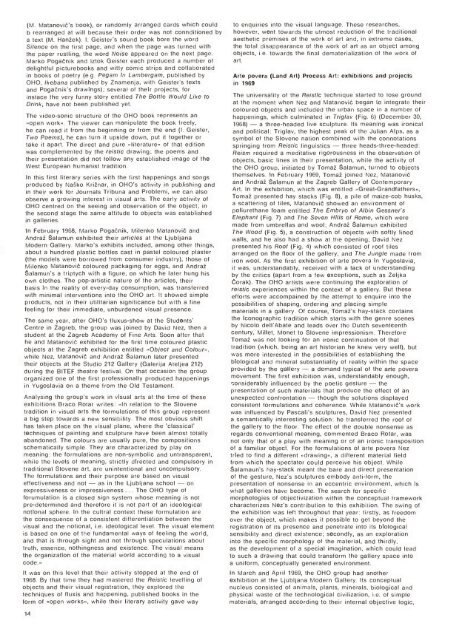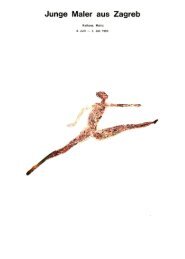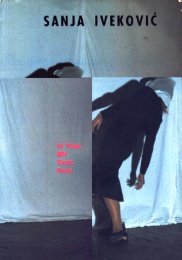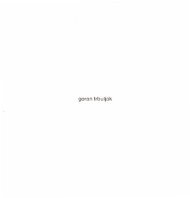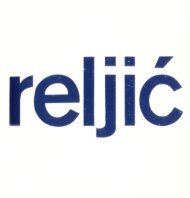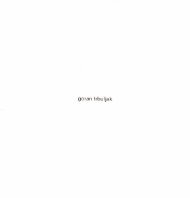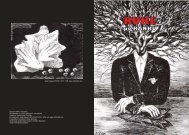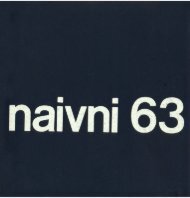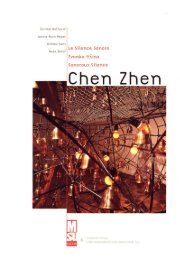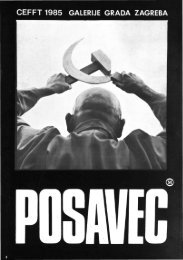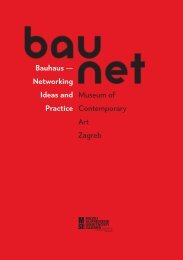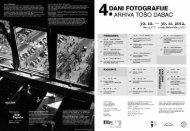The New Art Practice in Yugoslavia, 1966-1978
The New Art Practice in Yugoslavia, 1966-1978
The New Art Practice in Yugoslavia, 1966-1978
- TAGS
- practice
- yugoslavia
- www.msu.hr
Create successful ePaper yourself
Turn your PDF publications into a flip-book with our unique Google optimized e-Paper software.
(M. Matanovi's book), or randomly arranged cards which could<br />
b rearranged at will because their order was not connditioned by<br />
a text (M. Hanek). I. Geister's sound book bore the word<br />
Silence on the first page, and when the page was turned with<br />
the paper rustl<strong>in</strong>g, the word Noise appeared on the next page.<br />
Marko Poganik and Iztok Geister each produced a number of<br />
delightful picturebooks and witty comic strips and collaborated<br />
<strong>in</strong> books of poetry (e.g. Pegam <strong>in</strong> Lambergam, published by<br />
OHO, lkebana published by Znamenja, with Geister's texts<br />
and Poganik's draw<strong>in</strong>gs): several of their projects, for<br />
<strong>in</strong>stace the very funny story entitled <strong>The</strong> Bottle Would Like to<br />
Dr<strong>in</strong>k, have not been published yet.<br />
<strong>The</strong> video-sonic structure of the OHO book represents an<br />
«open work.. <strong>The</strong> viewer can manipulate the book freely,<br />
he can read it from the beg<strong>in</strong>n<strong>in</strong>g or from the end (I. Geister,<br />
Two Poems), he can turn it upside down, put it together or<br />
take it apart. <strong>The</strong> direct and pure «literature'. of that edition<br />
was complemented by the reistic draw<strong>in</strong>g; the poems and<br />
their presentation did not follow any established image of the<br />
West European humanist tradition.<br />
In this first literary series with the first happen<strong>in</strong>gs and songs<br />
produced by Nako Kr<strong>in</strong>ar, <strong>in</strong> OHO's activity <strong>in</strong> publish<strong>in</strong>g and<br />
<strong>in</strong> their work for Journals Tribuna and Problemi, we can also<br />
observe a grow<strong>in</strong>g <strong>in</strong>terest <strong>in</strong> visual arts. <strong>The</strong> early activity of<br />
OHO centred on the see<strong>in</strong>g and observation of the object; <strong>in</strong><br />
the second stage the same attitude to objects was established<br />
<strong>in</strong> galleries.<br />
In February 1968, Marko Poganik, Milenko Matanovi and<br />
Andra alamun exhibited their articles at the Ljubljana<br />
Modern Gallery. Marko's exhibits <strong>in</strong>cluded, among other th<strong>in</strong>gs,<br />
about a hundred plastic bottles cast <strong>in</strong> pastel coloured plaster<br />
(the models were borrowed from consumer <strong>in</strong>dustry), those of<br />
Milenko Matanovi coloured packag<strong>in</strong>g for eggs, and Andra<br />
alamun's a triptych with a figure, on which he later hung his<br />
own clothes. <strong>The</strong> pop-artistic nature of the articles, their<br />
basis <strong>in</strong> the reality of every-day consumption, was transferred<br />
with m<strong>in</strong>imal <strong>in</strong>terventions <strong>in</strong>to the OHO art. It showed simple<br />
products, not <strong>in</strong> their utilitarian significance but with a f<strong>in</strong>e<br />
feel<strong>in</strong>g for their immediate, unburdened visual presence.<br />
<strong>The</strong> same year, after OHO's fluxus-show at the Students'<br />
Centre <strong>in</strong> Zagreb, the group was jo<strong>in</strong>ed by David Nez, then a<br />
student at the Zagreb Academy of F<strong>in</strong>e <strong>Art</strong>s. Soon after that<br />
he and Matanovi exhibited for the first time coloured plastic<br />
objects at the Zagreb exhibition entitled «Object and Colour",<br />
while Nez, Matanovi and Andra alamun later presented<br />
their objects at the Studio 212 Gallery (Galerija Ateljea 212)<br />
dur<strong>in</strong>g the BITEF theatre festival. On that occasion the group<br />
organized one of the first professionally produced happen<strong>in</strong>gs<br />
<strong>in</strong> <strong>Yugoslavia</strong> on a theme from the Old Testament.<br />
Analys<strong>in</strong>g the group's work <strong>in</strong> visual arts at the time of these<br />
exhibitions Braco Rotar writes: «In relation to the Slovene<br />
tradition <strong>in</strong> visual arts the formulations of this group represent<br />
a big step towards a new sensibility. <strong>The</strong> most obvious shift<br />
has taken place on the visual plane, where the 'classical'<br />
techniques of pa<strong>in</strong>t<strong>in</strong>g and sculpture have been almost totally<br />
abandoned. <strong>The</strong> colours are usually pure, the compositions<br />
schematically simple. <strong>The</strong>y are characterized by play on<br />
mean<strong>in</strong>g: the formulations are non-symbolic and untransparent,<br />
while the levels of mean<strong>in</strong>g, strictly directed and compulsory <strong>in</strong><br />
traditional Slovene art, are un<strong>in</strong>tentional and uncompulsory.<br />
<strong>The</strong> formulations and their purpose are based on visual<br />
effectiveness and not as <strong>in</strong> the Ljubljana school on<br />
expressiveness or impressiveness ... <strong>The</strong> OHO type of<br />
forumulation is a closed sign system whose mean<strong>in</strong>g is not<br />
pre-determ<strong>in</strong>ed and therefore it is not part of an ideological<br />
notional sphere. In the cultral context these formulation are<br />
the consequence of a consistent differentiation between the<br />
visual and the notional, i.e. ideological level. <strong>The</strong> visual element<br />
is based on one of the fundamental ways of feel<strong>in</strong>g the world,<br />
and that is through sight and not through speculations about<br />
truth, essence, noth<strong>in</strong>gness and existence. <strong>The</strong> visual means<br />
the organization of the material world accord<strong>in</strong>g to a visual<br />
code..<br />
It was on this level that their activity stopped at the end of<br />
1968. By that time they had mastered the Reistic levell<strong>in</strong>g of<br />
objects and their visual registration, they explored the<br />
techniques of fluxis and happen<strong>in</strong>g, published books <strong>in</strong> the<br />
form of 'open works, while their literary activity gave way<br />
14<br />
to enquiries <strong>in</strong>to the visual language. <strong>The</strong>se researches,<br />
however, went towards the utmost reduction of the traditional<br />
aesthetic premises of the work of art and, <strong>in</strong> extreme cases,<br />
the total disappearance of the work of art as an object among<br />
objects, i.e. towards the f<strong>in</strong>al dematerialization of the work of<br />
art.<br />
<strong>Art</strong>e povera (Land <strong>Art</strong>) Process <strong>Art</strong>: exhibitions and projects<br />
<strong>in</strong> 1969<br />
<strong>The</strong> universality of the Reistic technique started to lose ground<br />
at the moment when Nez and Matanovi began to <strong>in</strong>tegrate their<br />
coloured objects and <strong>in</strong>cluded the urban space <strong>in</strong> a number of<br />
happen<strong>in</strong>gs, which culm<strong>in</strong>ated <strong>in</strong> Triglav (Fig. 6) (December 30,<br />
1968) a three-headed live sculpture. Its mean<strong>in</strong>g was ironical<br />
and political: Triglav, the highest peak of the Julian Alps, as a<br />
symbol of the Slovene nation comb<strong>in</strong>ed with the connotations<br />
spr<strong>in</strong>g<strong>in</strong>g from Reistic l<strong>in</strong>guistics three heads-three-headed:<br />
Reism required a meditative rigorousness <strong>in</strong> the observation of<br />
objects, basic l<strong>in</strong>es <strong>in</strong> their presentation, while the activity of<br />
the OHO group, <strong>in</strong>itiated by Toma alamun, turned to objects<br />
themselves. In February 1969, Toma jo<strong>in</strong>ed Nez, Matanovi<br />
and Andra alamun at the Zagreb Gallery of Contemporary<br />
<strong>Art</strong>. In the exhibition, which was entitled «Great-Grandfathers.,<br />
Toma presented hay stacks (Fig. 8), a pile of maize-cob husks,<br />
a scatter<strong>in</strong>g of tiles, Matanovi showed an environment of<br />
poliurethane foam entitled <strong>The</strong> Embryo of Alb<strong>in</strong> Gessner's<br />
Elephant (Fig. 7) and <strong>The</strong> Seven Hills of Rome, which were<br />
made from umbrellas and wool; Andra alamun exhibited<br />
<strong>The</strong> Wood (Fig. 5), a construction of objects with softly l<strong>in</strong>ed<br />
walls, and he also had a show at the open<strong>in</strong>g. David Nez<br />
presented his Roof (Fig. 4) which consisted of roof tiles<br />
arranged on the floor of the gallery, and <strong>The</strong> Jungle made from<br />
iron wool. As the first exhibition of arte povera <strong>in</strong> <strong>Yugoslavia</strong>,<br />
it was, understandably, received with a lack of understand<strong>in</strong>g<br />
by the critics (apart from a few exceptions, such as Zeljka<br />
Corak). <strong>The</strong> OHO artists were cont<strong>in</strong>u<strong>in</strong>g the exploration of<br />
reistic experiences with<strong>in</strong> the context of a gallery. But these<br />
efforts were accompa<strong>in</strong>ed by the attempt to enquire <strong>in</strong>to the<br />
possibilities of shap<strong>in</strong>g, order<strong>in</strong>g and plac<strong>in</strong>g simple<br />
materials <strong>in</strong> a gallery. Of course, Toma's hay-stack conta<strong>in</strong>s<br />
the iconographic tradition which starts with the genre scenes<br />
by Nicole dell'Abate and leads over the Dutch seventcenth<br />
century, Millet, Monet to Slovene impressionism. <strong>The</strong>refore<br />
Toma was not look<strong>in</strong>g for an ironic cont<strong>in</strong>uation of that<br />
tradition (which, be<strong>in</strong>g an art historian he knew very well), but<br />
was more <strong>in</strong>terested <strong>in</strong> the possibilities of establish<strong>in</strong>g the<br />
biological and m<strong>in</strong>eral substantiality of reality with<strong>in</strong> the space<br />
provided by the gallery a demand typical of the arte povera<br />
movement. <strong>The</strong> first exhibition was, understandably enough,<br />
-;onsiderably <strong>in</strong>fluenced by the poetic gesture the<br />
presentation of such materials that produce the effect of an<br />
unexpected confrontation though the solutions displayed<br />
consistent formulations and coherence. While Matanovi's work<br />
was <strong>in</strong>fluenced by Pascali's sculptures, David Nez presented<br />
a semantically <strong>in</strong>terest<strong>in</strong>g solution: he transferred the roof of<br />
the gallery to the floor. <strong>The</strong> effect of the double nonsense as<br />
regards conventional mean<strong>in</strong>g, commented Braco Rotar, was<br />
not only that of a play with mean<strong>in</strong>g or of an ironic transposition<br />
of a familiar object. For the formulations of arte povera Nez<br />
tried to f<strong>in</strong>d a different «draw<strong>in</strong>g., a different material field<br />
from which the spectator could perceive his object. While<br />
alamaun's hay-stack meant the bare and direct presentation<br />
of the gesture, Nez's sculptures embody anti-form, the<br />
presentation of nonsense <strong>in</strong> an eccentric environment, which is<br />
what galleries have become. <strong>The</strong> search for specific<br />
morphologies of objectivization with<strong>in</strong> the conceptual framework<br />
characterizes Nez's contribution to this exhibition. <strong>The</strong> sw<strong>in</strong>g of<br />
the exhibition was left throughout that year: firstly, as freedom<br />
over the object, which makes it possible to get beyond the<br />
registration of its presence and penetrate <strong>in</strong>to its biological<br />
sensibility and direct existence; secondly, as an exploration<br />
<strong>in</strong>to the specific morphology of the material, and thirdly,<br />
as the development of a special imag<strong>in</strong>ation, which could lead<br />
to such a draw<strong>in</strong>g that could transform the gallery space <strong>in</strong>to<br />
a uniform, conceptually generated environment.<br />
In March and April 1969, the OHO group had another<br />
exhibition at the Ljubljana Modern Gallery. Its conceptual<br />
nucleus consisted of animals, plants, m<strong>in</strong>erals, biological and<br />
physical waste of the technological civilization, i.e. of simple<br />
materials, arranged accord<strong>in</strong>g to their <strong>in</strong>ternal objective logic,


